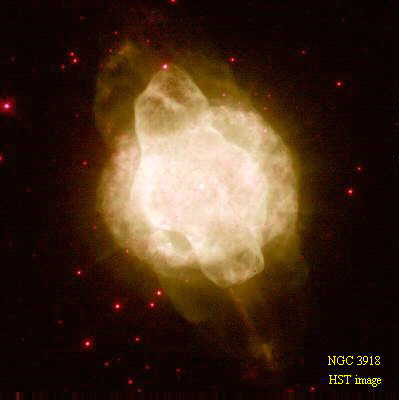 These layers continue to expand for perhaps another few million years, while
the star itself gets lower and lower on fuel. After the core collapses, it maintains
fusion until it once again runs out of hydrogen fuel, and the cycle starts over
again. It continues to a point where most of the hydrogen has been turned to
helium. Then, it may start to fuse helium to carbon. When this occurs, it occurs
suddenly, in a phenomenon called "Helium Flash over". The star suddenly starts
burning at a much higher temperature, but with less mass and less surface area,
it's much dimmer to those observing from far away. It has become a White Dwarf
star, with most of its energy being radiated in the far ultraviolet range of
the spectrum. So, while not very bright to our vision, ultraviolet radiation
is quite energetic, enough so that it quite easily ionizes the clouds of gas
left over from all the mass ejections that took place millions of years earlier.
What this means is the energy streaming from the star strips some of the electrons
from the gas atoms in the clouds. When this happens, the atom changes an energy
state, emitting a photon of light in the process, and the gas cloud glows. It's
the same principle at work in a florescent light bulb. The different densities
of the gas and the interaction of the star's solar winds is what creates the
images we see in the telescope's eyepiece. Famous planetary nebulae like the
Dumbbell, Ring, Helix and Saturn nebulae. Some not so famous, but still beautiful
ones like the Southern sky's NGC3918 in Centaurus pictured here, a nebulae that
contains so much structure, one can hardly imagine the violence of its birth,
belying the delicate structures within. Or an overlooked one in Orion-NGC2022,located
between Betelgeuse and Orion's head.
These layers continue to expand for perhaps another few million years, while
the star itself gets lower and lower on fuel. After the core collapses, it maintains
fusion until it once again runs out of hydrogen fuel, and the cycle starts over
again. It continues to a point where most of the hydrogen has been turned to
helium. Then, it may start to fuse helium to carbon. When this occurs, it occurs
suddenly, in a phenomenon called "Helium Flash over". The star suddenly starts
burning at a much higher temperature, but with less mass and less surface area,
it's much dimmer to those observing from far away. It has become a White Dwarf
star, with most of its energy being radiated in the far ultraviolet range of
the spectrum. So, while not very bright to our vision, ultraviolet radiation
is quite energetic, enough so that it quite easily ionizes the clouds of gas
left over from all the mass ejections that took place millions of years earlier.
What this means is the energy streaming from the star strips some of the electrons
from the gas atoms in the clouds. When this happens, the atom changes an energy
state, emitting a photon of light in the process, and the gas cloud glows. It's
the same principle at work in a florescent light bulb. The different densities
of the gas and the interaction of the star's solar winds is what creates the
images we see in the telescope's eyepiece. Famous planetary nebulae like the
Dumbbell, Ring, Helix and Saturn nebulae. Some not so famous, but still beautiful
ones like the Southern sky's NGC3918 in Centaurus pictured here, a nebulae that
contains so much structure, one can hardly imagine the violence of its birth,
belying the delicate structures within. Or an overlooked one in Orion-NGC2022,located
between Betelgeuse and Orion's head.Here is a link to a wonderfully amazing web site by Doug Snyder . It contains the most comprehensive catalog of planetary nebulae I've ever seen. It has some photos and locations and lots of statistics on planetary nebulae, organized by constellation and position etc. Enjoy it, as I did and as always, if you have any questions, please feel free to email me.